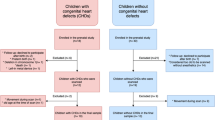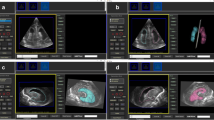Abstract
Purpose
We calculated the brain volumes of preterm infants using two-dimensional cranial ultrasonography and explored the relationships thereof with neurodevelopment.
Methods
Cranial measurements were derived using routine ultrasonographic scanning. The brain was considered to be an ellipsoid and estimated absolute brain volumes (EABVs) were calculated by substracting the volumes of the two lateral ventricles from the total brain volumes.
Results
We enrolled preterm infants of mean gestational age 28 ± 2 weeks and mean birthweight 973 ± 187 g. Twenty-one exhibited dilated ventricles; their EABVs were lower than normal (206 ± 11 cm3 vs. 275 ± 17 cm3, p < 0.001). The mental development indices were similar (74 ± 5 vs. 78 ± 14, p = 0.069), but the psychomotor development indices (PDIs) differed significantly (77 ± 7 vs. 86 ± 17, p = 0.001). We found a slight positive correlation between the PDI and EABV (r = + 0.258, p = 0.012).
Conclusion
The EABV can be calculated using two-dimensional measurements and low EABV found to be associated with poor neurological outcomes.
Trial registration
NCT02848755



Similar content being viewed by others
Data availability
The datasets used and/or analyzed during the current study are available from the corresponding author on reasonable request.
Abbreviations
- APD, FOD:
-
Postero-anterior diameter
- BPDia:
-
Bi-parietal diameter
- cPVL:
-
Cystic periventricular leukomalacia
- CrUS:
-
Cranial ultrasonography
- EABV:
-
Estimated absolute brain volume
- ICH:
-
Intracranial height
- MRI:
-
Magnetic resonance imaging
- NICU:
-
Neonatal intensive care unit
- TOD:
-
Thalamo-occipital distance
- US:
-
Ultrasonography
- VH:
-
Ventricular height
- VI:
-
Ventricular index
- 2D:
-
Two-dimensional
- 3D:
-
Three-dimensional
References
Pappas A, Adams-Chapman I, Shankaran S, McDonald SA, Stoll BJ, Laptook AR, Carlo WA, Van Meurs KP, Hintz SR, Carlson MD, Brumbaugh JE, Walsh MC, Wyckoff MH, Das A, Higgins RD, Eunice Kennedy Shriver National Institute of Child Health and Human Development Neonatal Research Network (2018) Neurodevelopmental and behavioral outcomes in extremely premature neonates with ventriculomegaly in the absence of periventricular-intraventricular hemorrhage. JAMA Pediatr 172:32–42
Miller SP, Ferriero DM, Leonard C et al (2005) Early brain injury in premature newborns detected with magnetic resonance imaging is associated with adverse early neurodevelopmental outcome. J Pediatr 147:609–616
Inder TE, Wells SJ, Mogridge NB, Spencer C, Volpe JJ (2003) Defining the nature of the cerebral abnormalities in the premature infant: a qualitative magnetic resonance imaging study. J Pediatr 143:171–179
Woodward LJ, Clark CA, Bora S, Inder TE (2012) Neonatal white matter abnormalities an important predictor of neurocognitive outcome for very preterm children. PLoS One 7(12):e51879
Horsch S, Bengtsson J, Nordell A, Lagercrantz H, Adén U, Blennow M (2009) Lateral ventricular size in extremely premature infants: 3D MRI confirms 2D ultrasound measurements. Ultrasound Med Biol 35:360–366
Anderson NG, Warfield SK, Wells S, Spencer C, Balasingham A, Volpe JJ, Inder TE (2004) A limited range of measures of 2-D ultrasound correlate with 3-D MRI cerebral volumes in the premature infant at term. Ultrasound Med Biol 30:11–18
Kadioglu Simsek G, Canpolat FE, Buyuktiryaki M, Kanmaz Kutman HG, Tayman C (2019) Brain volumes of very low birth weight infants measured by two dimensional cranial ultrasonography, a prospective cohort study. Current Medical Imaging 15:994–1000
Vergnano S, Sharland M, Kazembe P, Mwansambo C, Heath PT (2005) Neonatal sepsis: an international perspective. Arch Dis Child Fetal Neonatal Ed 90:F220–F224
Jobe AH, Bancalari EH (2017) Controversies about the definition of bronchopulmonary dysplasia at 50 years. Acta Paediatr 106:692–693
Papile L-A, Burstein J, Burstein R, Koffler H (1978) Incidence and evolution of subependymal and intraventricular hemorrhage: a study of infants with birth weight less than 1500 gm. J Pediatr 92:529–534
Levene MI (1981) Measurement of the growth of the lateral ventricles in preterm infants with real-time ultrasound. Arch Dis Child 56:900–904
Brouwer MJ, de Vries LS, Groenendaal F, Koopman C, Pistorius LR, Mulder EJ, Benders MJ (2012) New reference values for the neonatal cerebral ventricles. Radiology 262:224–233
Davies MW, Swaminathan M, Chuang SLBF (2000) Reference ranges for the linear dimensions of the intracranial ventricles in preterm neonates. Arch Dis Child Fetal Neonatal Ed 82:F218–F223
Graca AM, Cardoso KR, da Costa JM, Cowan FM (2013) Cerebral volume at term age:comparison between preterm and term-born infants using cranial ultrasound. Early Hum Dev 89:643–648
Maunu J, Lehtonen L, Lapinleimu H, Matomäki J, Munck P, Rikalainen H, Parkkola R, Haataja L, PIPARI Study Group (2011) Ventricular dilatation in relation to outcome at 2 years of age in very preterm infants: a prospective Finnish cohort study. Dev Med Child Neurol 53:48–54
Maunu J, Parkkola R, Rikalainen H, Lehtonen L, Haataja L, Lapinleimu H, PIPARI Group (2009) Brain and ventricles in very low birth weight infants at term: a comparison among head circumference, ultrasound, and magnetic resonance imaging. Pediatrics 123:617–626
Liao MF, Chaou WT, Tsao LY, Nishida H, Sakanoue M (1986) Ultrasound measurement of the ventricular size in newborn infants. Brain and Development 8:262–268
Reeder JD, Kaude JV, Setzer ES (1983) The occipital horn of the lateral ventricles in premature infants. An ultrasonographic study. Eur J Radiol 3:148–150
Hüning B, Storbeck T, Bruns N, Dransfeld F, Hobrecht J, Karpienski J, Sirin S, Schweiger B, Weiss C, Felderhoff-Müser U, Müller H (2018) Relationship between brain function (aEEG) and brain structure (MRI) and their predictive value for neurodevelopmental outcome of preterm infants. Eur J Pediatr 177:1181–1189
Author information
Authors and Affiliations
Contributions
GKS and FEC made crUS, EO and MK entered data to database, GKS and FEC analyzed them, HGKK and MB helped patient evaluation and data analysis, FEC and GKS wrote the manuscript, and ZÜ made developmental assessments.
Corresponding author
Ethics declarations
Conflict of interest
The authors declare that they have no conflict of interest.
Ethical approval
All study approvals (local institutional review board: Zekai Tahir Burak Hospital Specialty Educational Review Board [TUEK]; ethics board: Zekai Tahir Burak Hospital Clinical Ethics Committee) and parental consent (in verbal form because CrUS is routine during hospitalization in the NICU) were received prior to study initiation.
Informed consent
Informed consent was obtained from all individual participants included in the study.
Additional information
Publisher’s note
Springer Nature remains neutral with regard to jurisdictional claims in published maps and institutional affiliations.
What is already known?
1. Ventricular dilatation in preterm infants is associated with poor neurological outcomes.
2. Brain volume can be calculated using advanced imaging techniques such as magnetic resonance imaging.
3. Magnetic resonance imaging results confirm measurements made using transfontanelle cranial ultrasonography.
What is new?
1. Brain volume can be calculated using two-dimensional ultrasonographic measurements in low-resource settings.
2. The subtraction of ventricular volumes from the total brain volume yields an absolute brain volume.
3. The estimated absolute brain volumes of preterm infants can be obtained using two-dimensional ultrasonographic measurements and correlate positively with neurodevelopmental scores.
Rights and permissions
About this article
Cite this article
Şimşek, G.K., Canpolat, F.E., Büyüktiryaki, M. et al. Developmental outcomes of very low birthweight infants with non-hemorrhagic ventricular dilatations and the relationships thereof with absolute brain volumes measured via two-dimensional ultrasonography. Childs Nerv Syst 36, 1231–1237 (2020). https://doi.org/10.1007/s00381-019-04464-x
Received:
Accepted:
Published:
Issue Date:
DOI: https://doi.org/10.1007/s00381-019-04464-x




